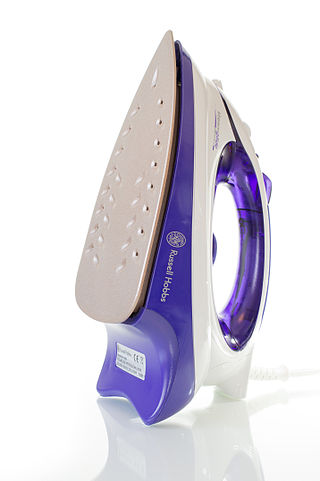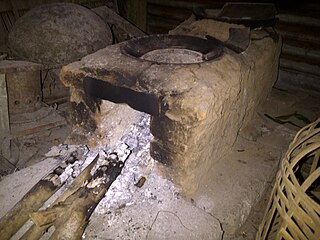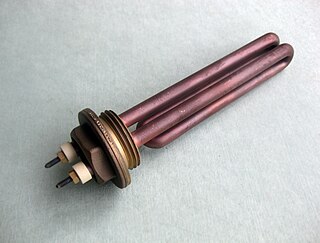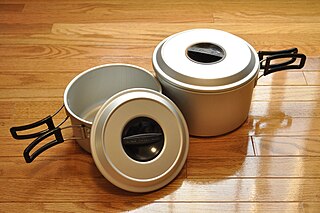
A branding iron is used for branding, pressing a heated metal shape against an object or livestock with the intention of leaving an identifying mark.

A branding iron is used for branding, pressing a heated metal shape against an object or livestock with the intention of leaving an identifying mark.
The history of branding is very much tied to the history of using animals as a commodity. The act of marking livestock with fire-heated marks to identify ownership begins in ancient times with the ancient Egyptians. [1] The process continued throughout the ages, with both Romans and American colonists using the process to brand slaves as well. [2]
In the English lexicon, the Germanic word "brand" originally meant anything hot or burning, such as a fire-brand, a burning stick. By the European Middle Ages it commonly identified the process of burning a mark into a stock animals with thick hides, such as cattle, so as to identify ownership under animus revertendi. In England, the rights of common including the common pasture system meant that cattle could be grazed on certain land with commoner's rights and the cattle were branded to show ownership, often with the commoner's or Lord of the manor's mark. The practice was widespread in most European nations with large cattle grazing regions, including Spain.
With colonialism, many cattle branding traditions and techniques were spread via the Spanish Empire to South America and to countries of the British Empire including the Americas, Australasia & South Africa where distinct sets of traditions and techniques developed respectively.
In the Americas these European systems continued with English tradition being used in the New England Colonies and spread outwards with the western expansion of the U.S. The Spanish system evolved from the south with the vaquero tradition in what today is the southwestern United States and northern Mexico. The branding iron consisted of an iron rod with a simple symbol or mark which was heated in a fire. After the branding iron turned red-hot, the cowhand pressed the branding iron against the hide of the cow. The unique brand meant that cattle owned by multiple owners could then graze freely together on the commons or open range. Drovers or cowboys could then separate the cattle at roundup time for driving to market.
Branding Irons come in a variety of styles, designed primarily by their method of heating.
The traditional fire-heated method is still in use today. While they require longer lengths of time to heat, are inconsistent in temperature and all around inferior to more advanced forms of branding, they are inexpensive to produce and purchase. Fire-heated branding irons are used to brand wood, steak, leather, livestock and plastics.
Electric branding irons utilize an electric heating element to heat a branding iron to the desired temperature. Electric branding irons come in many variations from irons designed to brand cattle, irons designed to mark wood and leather and models designed to be placed inside a drill press for the purposes of manufacturing. An electric branding iron’s temperature can be controlled by increasing or decreasing the flow of electricity.
Propane Branding Irons use a continuous flow of propane to heat the iron head. They are commonly used where electricity is not available. Utilizing the flow of propane, the temperature can be adjusted for varying branding environments.
A commercially built branding iron heater fired with L.P. gas is a common method of heating several branding irons at once. [3]
In stark contrast to traditional hot-iron branding, freeze branding uses an iron that has been chilled with a coolant such as dry ice or liquid nitrogen. Instead of burning a scar into the animal's skin, a freeze brand damages the pigment-producing hair cells, causing the animal's hair to grow back white within the branded area. This white-on-dark pattern is prized by cattle ranchers as its contrast allows some range work to be conducted with binoculars rather than individual visits to every animal. To apply a freeze brand the hair coat of the animal is first shaved very closely so that bare skin is exposed. Then the frozen iron is pressed to the animal's bare skin for a period of time that varies with both the species of animal and the color of its hair coat. Shorter times are used on dark-colored animals, as this causes follicle melanocyte death and hence permanent pigment loss to the hair when it regrows. Longer times, sometimes as little as five seconds more, are needed for animals with white hair coats. In these cases the brand is applied for long enough to kill the cells of the growth follicle, those that create the hair filaments themselves. This leaves the animal permanently bald in the branded area. The somewhat darker epidermis then contrasts well with a pale animal's coat. [4]
Livestock branding is perhaps the most prevalent use of a branding iron. Modern use includes gas heating, the traditional fire-heated method, an iron heated by electricity (electric cattle branding iron) or an iron super cooled by dry ice (freeze branding iron). Cattle, horses and other livestock are commonly branded today for the same reason they were in Ancient times, to prove ownership.
Woodworkers will often use Electric or Fire-Heated Branding Irons to leave their maker's mark or company logo. Timber pallets and other timber export packaging is often marked in this way in accordance with ISPM 15 to indicate that the timber has been treated to prevent it carrying pests.
Steak branding irons are used commonly by barbecue enthusiasts and professional chefs to leave a mark indicating how well done a steak is or to identify the chef or grill master.
Branding Irons are used often by makers of horse tack often in place of a steel leather stamp to indicate craftsmanship.

A soldering iron is a hand tool used in soldering. It supplies heat to melt solder so that it can flow into the joint between two workpieces.

Grilling is a form of cooking that involves heat applied to the surface of food, commonly from above, below or from the side. Grilling usually involves a significant amount of direct, radiant heat, and tends to be used for cooking meat and vegetables quickly. Food to be grilled is cooked on a grill, using a cast iron/frying pan, or a grill pan.

A griddle, in the UK also called a girdle, is a cooking device consisting mainly of a broad, usually flat cooking surface. Nowadays it can be either a movable metal pan- or plate-like utensil, a flat heated cooking surface built into a stove or kitchen range, or a compact cooking machine with its own heating system attached to an integrated griddle acting as a cooktop.

A clothes iron is a small appliance that, when heated, is used to press clothes to remove wrinkles and unwanted creases. Domestic irons generally range in operating temperature from between 121 °C (250 °F) to 182 °C (360 °F). It is named for the metal (iron) of which the device was historically made, and the use of it is generally called ironing, the final step in the process of laundering clothes.

A stove or range is a device that burns fuel or uses electricity to generate heat inside or on top of the apparatus, to be used for general warming or cooking. It has evolved highly over time, with cast-iron and induction versions being developed. Stoves can be powered with many fuels, such as electricity, gasoline, wood, and coal.

A hair iron or hair tong is a tool used to change the arrangement of the hair using heat. There are three general kinds: curling irons, used to make the hair curly, straightening irons, commonly called straighteners or flat irons, used to straighten the hair, and crimping irons, used to create crimps of the desired size in the hair.
A fireplace or hearth is a structure made of brick, stone or metal designed to contain a fire. Fireplaces are used for the relaxing ambiance they create and for heating a room. Modern fireplaces vary in heat efficiency, depending on the design.

Livestock branding is a technique for marking livestock so as to identify the owner. Originally, livestock branding only referred to hot branding large stock with a branding iron, though the term now includes alternative techniques. Other forms of livestock identification include freeze branding, inner lip or ear tattoos, earmarking, ear tagging, and radio-frequency identification (RFID), which is tagging with a microchip implant. The semi-permanent paint markings used to identify sheep are called a paint or color brand. In the American West, branding evolved into a complex marking system still in use today.

A heating element converts electrical energy into heat through the process of Joule heating. Electric current through the element encounters resistance, resulting in heating of the element. Unlike the Peltier effect, this process is independent of the direction of current.

A waffle iron or waffle maker is a kitchen utensil used to cook waffles between two hinged metal plates. Both plates have gridded indentations to shape the waffle from the batter or dough placed between them. The plates are heated and the iron is closed while the waffle bakes. Waffle irons are required to cook waffles due to their distinctive shape, which is much harder to achieve than that of a pancake. Similar technology is employed to bake wafers, as well as several other snacks including kue gapit, a waffle-shaped but crunchy Indonesian snack which can be made with both sweet and savoury flavours.

Human branding or stigmatizing is the process by which a mark, usually a symbol or ornamental pattern, is burned into the skin of a living person, with the intention that the resulting scar makes it permanent. This is performed using a hot or very cold branding iron. It therefore uses the physical techniques of livestock branding on a human, either with consent as a form of body modification; or under coercion, as a punishment or to identify an enslaved, oppressed, or otherwise controlled person. It may also be practiced as a "rite of passage", e.g. within a tribe, or to signify membership of or acceptance into an organization.

A heat gun is a device used to emit a stream of hot air, usually at temperatures between 100 and 550 °C, with some hotter models running around 760 °C, which can be held by hand. Heat guns usually have the form of an elongated body pointing at what is to be heated, with a handle fixed to it at right angles and a pistol grip trigger in the same pistol form factor as many other power tools.

A convection heater is a heater that uses convection currents to heat and circulate air. These currents circulate throughout the body of the appliance and across its heating element. This process, following the principle of thermal conduction, heats up the air, reducing its density relative to colder air and causing it to rise.

Markings on horses are usually distinctive white areas on an otherwise dark base coat color. Most horses have some markings, and they help to identify the horse as a unique individual. Markings are present at birth and do not change over the course of the horse's life. Most markings have pink skin underneath most of the white hairs, though a few faint markings may occasionally have white hair with no underlying pink skin. Markings may appear to change slightly when a horse grows or sheds its winter coat, however this difference is simply a factor of hair coat length; the underlying pattern does not change.

Cooker may refer to several types of cooking appliances and devices used for cooking foods.

Ironing is the use of an iron, usually heated, to remove wrinkles and unwanted creases from fabric. The heating is commonly done to a temperature of 180–220 °Celsius, depending on the fabric. Ironing works by loosening the bonds between the long-chain polymer molecules in the fibres of the material. While the molecules are hot, the fibres are straightened by the weight of the iron, and they hold their new shape as they cool. Some fabrics, such as cotton, require the addition of water to loosen the intermolecular bonds. Many modern fabrics are advertised as needing little or no ironing. Permanent press clothing was developed to reduce the ironing necessary by combining wrinkle-resistant polyester with cotton.

Soldering is a process of joining two metal surfaces together using a filler metal called solder. The soldering process involves heating the surfaces to be joined and melting the solder, which is then allowed to cool and solidify, creating a strong and durable joint.

Animal identification using a means of marking is a process done to identify and track specific animals. It is done for a variety of reasons including verification of ownership, biosecurity control, and tracking for research or agricultural purposes.

Freeze branding is a technique involving a cryogenic coolant instead of heat to produce permanent marks on a variety of animals.
To improve efficiency, cattle producers should place a high priority on identifying individual cattle and maintaining accurate records.